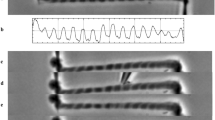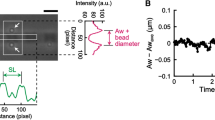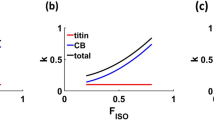Abstract
Like any other signals, optical signals from muscle fibres inevitably contain noise. The noise here is of predictable character. Because the structure of muscle is periodic, or almost so, translational movement of an illuminated fibre will inevitably give rise to a periodic noise fluctuation as striations pass across the optical field. The frequency of this fluctuation should be linearly related to the speed at which the fibre translates. By mistaking this noise component for the signal, Altringham and colleagues1 have amply succeeded in confirming this expected relationship, but they have left unanswered the question of the source and nature of stepwise shortening. I show here that: (1) by having obtained records in conditions in which the noise dominated, Altringham et al. have inadvertently confused the steps with the translation-induced fluctuation; and (2) when records are obtained using a method designed specifically to circumvent the effects of translation, the steps still remain in evidence.
This is a preview of subscription content, access via your institution
Access options
Subscribe to this journal
Receive 51 print issues and online access
$199.00 per year
only $3.90 per issue
Buy this article
- Purchase on Springer Link
- Instant access to full article PDF
Prices may be subject to local taxes which are calculated during checkout
Similar content being viewed by others
References
Altringham, J. D., Bottinelli, R. & Lacktis, J. W. Nature 307, 653–655 (1984).
Pollack, G. H., Iwazumi, T., ter Keurs, H. E. D. J. & Shibata, E. F. Nature 268,757–759 (1977).
Pollack, G. H., Vassallo, D. V., Jacobson, R. C., Iwazumi, T. & Delay, M. J. in Cross-bridge Mechanism in Muscle Contraction (eds Sugi, H. & Pollack, G. H.) 23–40 (University of Tokyo Press, 1979).
Jacobson, R. C., Tirosh, R., Delay, M. J. & Pollack, G. H. J. Muscle Res. Cell Motility 4, 529–542 (1983).
Myers, J., Tirosh, R., Jacobson, R. C. & Pollack, G. H. IEEE Trans, biomed. Engng 29, 463–466 (1982).
Granzier, H. L. M., Brozovich, F. V., Rowinski, S., Myers, J. & Pollack, G. H. Biophys. J. 42 (in the press).
Gordon, A. M., Huxley, A. F. & Julian, F. J. J. Physiol., Lond. 184, 143–169 (1966).
Edman, P., Elzinga, G. & Noble, M. I. M. J. gen. Physiol. 80, 769–784 (1982).
Housmans, P. R. in Contractile Mechanisms in Muscle (eds Pollack, G. H. & Sugi, H.) 782–784 (Plenum, New York, 1984).
Rüdel, R. & Zite-Ferenczy, F. Nature 278, 573–575 (1979).
Morgan, D. L. Biophys. J. 21, 89a (1978).
Goldman, Y. E. Biophys. J. 41, 251a (1983).
Roos, K. P., Baskin, R. J., Lieber, R. L., Cline, J. W. & Paolini, P. J. Rev. sci. Instrum. 51, 762–767 (1980).
Delay, M. J., Ishide, N., Jacobson, R. C., Pollack, G. H. & Tirosh, R. Science 213,1523–1525 (1981).
Brozovich, F. V., Granzier, H. L. M. & Pollack, G. H. (in preparation).
Author information
Authors and Affiliations
Rights and permissions
About this article
Cite this article
Pollack, G. Is stepwise sarcomere shortening an artefact?—a response. Nature 309, 712–713 (1984). https://doi.org/10.1038/309712a0
Received:
Accepted:
Issue Date:
DOI: https://doi.org/10.1038/309712a0
This article is cited by
-
Stepwise shortening of muscle fibre segments
Journal of Muscle Research and Cell Motility (1987)
-
Correlation between the light diffraction pattern and the structure of a muscle fibre realized with Ewald's construction
Journal of Muscle Research and Cell Motility (1986)
Comments
By submitting a comment you agree to abide by our Terms and Community Guidelines. If you find something abusive or that does not comply with our terms or guidelines please flag it as inappropriate.



